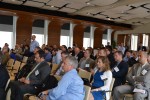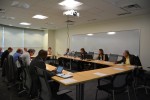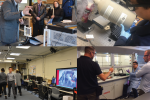News & Events
ALERT Program
Rappaport Delivers IEEE Distinguished Lectures in Australia and New Zealand November 27, 2017

November 27, 2017
ALERT Deputy Director and Northeastern University Electrical and Computer Engineering Distinguished Professor, Carey Rappaport, delivered three IEEE Distinguished Lectures in Australia and New Zealand earlier this month. The IEEE Antennas and Propagation Society (AP-S) selected Professor Rappaport as a Distinguished Lecturer for 2017-2019. The IEEE AP-S Distinguished Lecturer Program sends experts, the Distinguished Lecturers, to visit active IEEE AP-S Chapters around the world and give talks on topics of interest and importance to the Antennas and Propagation community. Professor Rappaport gave the following talks during his recent visit to Australia and New Zealand:
- “Electromagnetic Sensing and Treatment of Living Things: Using Microwaves to Detect and Treat Disease in Humans and Trees” (Melbourne, Australia)
- “A High Gain Toroidal Reflector Antenna for Multistatic 3D Whole Body Millimeter-Wave Imaging” (Queenstown, New Zealand)
- “Multifocal Bootlace Lens Design Concepts” (Sydney, Australia)
On the value of being an IEEE Distinguished Lecturer, Professor Rappaport states, “The IEEE Distinguished Lecturer Program supports one of the fundamental precepts of academic research: extending the dissemination of knowledge and cutting-edge discovery to as wide an audience as possible. In presenting my team’s engineering work around the world, I have been able to help engineers extend their scientific awareness beyond their traditional themes, and occasionally outside their comfort zones. Although the travel commitment is time-consuming, it has been a great opportunity to meet people and exchange technical ideas.” Professor Rappaport will be delivering another IEEE Distinguished Lecture in January 2018 to the IEEE AP-S chapter in Orlando, Florida.
Professor Rappaport has been a Northeastern University faculty member since 1987, becoming a full professor in Electrical and Computer Engineering in July 2000, and receiving an appointment as a College of Engineering Distinguished Professor in 2011. Professor Rappaport has written over 400 technical journal articles and conference papers on various topics, including electromagnetic wave propagation and scattering computation, microwave antenna design, and bioelectromagnetics. He has also received two reflector antenna patents, two biomedical device patents, and four subsurface sensing device patents.
ADSA17 Presentations Now Available November 10, 2017

We are pleased to announce that the presentations from The Seventeenth Advanced Development for Security Applications Workshop (ADSA17) which was held on October 17-18, 2017 at Northeastern University in Boston, MA are now available for download. The presentations from the ADSA17 Workshop are now available at the following link: https://alert.northeastern.edu/transitioning-technology/adsa/final-reports-and-presentations/adsa17-presentations/
The title of the workshop was, “Systems Engineering of Aviation Security Systems.” View all slides, as well as the reports from past ADSA workshops here.
If you have any questions regarding the topics and technologies discussed at the workshop, please contact ALERT at [email protected].
Upcoming 2017 Industrial Advisory Board Meeting September 27, 2017

ALERT is once again hosting its annual Industrial Advisory Board (IAB) meeting at the Kostas Research Institute in Burlington, MA. The October 16th event will include many of ALERT’s industrial members, representatives from ALERT’s DHS Office of University Program (OUP) customers and other DHS components, such as DHS S&T, Federal Emergency Management Agency (FEMA), and Customs and Border Protection (CBP), as well as a representative from the Occupational Safety and Health Administration (OSHA).
The agenda has evolved to include two guest speakers, a student poster session, and networking reception. Additionally, the event will include welcome remarks from Tim Connelly, the Executive Director of the Massachusetts Technology Collaborative, a faculty speaker, a testimonial of successful government/faculty/industry collaboration within ALERT, and a tour of the ALERT Video Analytics Laboratory. Presenters include:
- Guest Presenter: Thriving in the Innovation Economy through Collaborations of Government, Universities, and Industry, Gary Markovits, CEO, Innovation Business Partners, Inc.
- Guest Presenter: Guardian Centers Capabilities and Case Studies, Tim Maloney, VP, Business Development, Guardian Centers, LLC
- Industry Presenter: An ALERT Case Study for Successful Collaboration and Transition, Jeff Schubert, Sr. Staff Scientist, AS&E
- Research Presenter: Imaging at Speed Using a Multicoded Compressive System, Jose Martinez-Lorenzo, Assistant Professor, Mechanical and Industrial Engineering Jointly Appointed, Electrical and Computer Engineering, Northeastern University
ALERT’s annual IAB Meeting, and other members-only events give industrial members the opportunity to network with other members, faculty from ALERT’s partner institutions, and local, state, and federal representatives. Other advantages of ALERT industrial membership include admission to the Annual Student Pipeline Industry Roundtable Event (ASPIRE), providing industrial members with access to qualified job-seeking students; the opportunity to request targeted research in an area of interest to their organizations; and waivers of ALERT workshop registration fees. For more advantages of ALERT industrial membership, please see the Benefits of Collaboration, or contact our Industrial and Government Liaison Officer, Ms. Emel Bulat at [email protected].
Student Spotlight: Elizabeth Wig September 27, 2017

Congratulations to Elizabeth Wig, a Northeastern University (NU) Electrical Engineering undergraduate conducting ALERT research, for receiving the Society of Women Engineers GE Women’s Network Scholarship! Elizabeth will receive this award, which comes with a $5,000 stipend, in October 2017 at the SWE Annual Conference in Austin, Texas. Elizabeth has been working with ALERT R3 Thrust Leader, Professor Carey Rappaport since Summer 2016, conducting research on “Computational Models & Algorithms for Millimeter Wave Whole Body Scanning for AIT,” in collaboration with Smiths Detection (Project R3-A.2). When asked how Elizabeth got involved with the project so early on in her undergraduate career, she explained that she met Professor Rappaport at a NU-sponsored ski event and found out about his research while riding up the mountain on a chairlift. However, Elizabeth explained that her interest in this research began much earlier, “When my high school physics class did its electricity and magnetism unit, the symmetry was strikingly beautiful. I loved the way relatively few equations could describe so much of what makes up our world, from why sunrises are so beautiful to the way molecules hold together to Wi-Fi.” The aspect of her research that she is most passionate about is math, and learning about the different ways mathematics can be used to describe and explain our world. This fits in well with her role on the project, which involves developing the model used to detect and characterize potential explosives threats and eliminate false alarms using a millimeter-wave body scanner. She has been working to make and refine the model to improve the accuracy in characterization.
Beyond her recent award, Elizabeth has also published a paper on her work with Mahdiar Sadeghi, a Northeastern graduate student, and Professor Rappaport, and is currently working on her second paper. She and Mahdiar were also asked to present their work at the ADSA15 (Advanced Development for Security Applications) Workshop in November 2016.
Elizabeth has already gained valuable work experience through her Spring 2017 co-op position at Draper Laboratories in Cambridge, MA. There she worked on electrical engineering projects in their Sensors and Imaging Systems group. As for her future career, she hopes to continue her education and complete a Ph.D. program, and if possible, get the opportunity to travel more internationally and work with NASA!
ALERT Researcher Awards & Accomplishments September 27, 2017

September 26, 2017
Professor Bouman Nominated for ACM Gordon Bell Prize
Professor Charles Bouman of Purdue University has been nominated for an ACM (Association for Computing Machinery) Gordon Bell Prize. Professor Bouman co-leads research on the ALERT project, “Toward Advanced Baggage Screening: Reconstruction and Automatic Target Recognition (ATR)” (Project R4-B.1), with the overarching goal of finding the best mapping method from X-ray data to a decision on the relative safety of individual bags in security settings, such as airport checkpoints. Professor Bouman and his research team study the reconstruction problem with the end goal of detection, while also designing algorithms for image analysis that can best exploit the improved image quality in iterative methods. Their aim is to reduce the false alarm rate without sensitivity loss in detection. They hope to eventually reduce security costs to the transportation industry.
The Gordon Bell Prize is awarded each year to recognize outstanding achievement in high-performance computing. The purpose of the award is to track the progress over time of parallel computing, with particular emphasis on rewarding innovation in applying high-performance computing to applications in science, engineering, and large-scale data analytics. Prizes may be awarded for peak performance or special achievements in scalability and time-to-solution on important science and engineering problems.
Professor Jose Martinez-Lorenzo Awarded $546K DOE Grant
Professor Jose Martinez-Lorenzo of Northeastern University was awarded a $546K grant from the Department of Energy (DOE) for “Fusing Thermoacoustic, Electromagnetic and Acoustic/Seismic Wave Fields for Subsurface Characterization and Imaging of Flow Transport.” According to the DOE, “The overarching goal of this research program is to gain knowledge on the theory and experimental validation of a new unified sensing and imaging methodology for coupling Electromagnetic (EM), Acoustic/Seismic (AC/S), and novel Thermoacoustic (TA) physical fields, which will be applicable to multi-physics and multi-scale material characterization and underground imaging of fluid flow in porous media.” This research will help Professor Martinez-Lorenzo build upon his work with ALERT, specifically Project R3-B.1 and Project R3-B.2.
Professor Otto Gregory Awarded Patent for Gas Sensor System
Professor Otto Gregory of the University of Rhode Island was awarded a patent for “Systems and Methods for the Detection of Compounds” on September 12, 2017. Triacetone-Triperoxide (TATP) is an explosive commonly used in improvised explosive devices (IEDs) and is very difficult to detect using conventional explosives detection techniques, because most of these techniques were developed for nitrogen-based chemistries, not peroxide-based chemistries. In addition, TATP readily sublimes at room temperature, meaning that it can only be found in relatively high concentrations in the vapor phase compared to other commonly found explosives used in IEDs. Professor Gregory’s invention provides a gas sensor system for detection of a compound that decomposes upon exposure to a metal oxide catalyst, and incorporates the exposure of the compound to a microheater, which allows accurate detection to occur at smaller concentrations. For more information on Professor Gregory’s research with ALERT, see Project R2-B.1.
ALERT Phase 2 Year 4 Annual Report Available Online! September 27, 2017

ALERT is proud to announce that the Phase 2 Year 4 Annual Report is now available for download online. This report details the continued research in ALERT’s four thrusts:
- R1 Characterization & Elimination of Illicit Explosives
- R2 Trace & Vapor Sensors
- R3 Bulk Sensors & Sensor Systems
- R4 Video Analytics & Signature Analysis
A full bibliography of publications and presentations conducted under ALERT support follows the individual project reports. Comprehensive descriptions of the Year 4 activities that took place in our Research and Transition, Education, Strategic Studies, Safety, and Information Protection Programs, as well as the ALERT Phase 2 Overview and Year 4 Highlights, Infrastructure and Evaluation, and Industrial/Practitioner and Government Partnerships can also be accessed in the Annual Report.
DEADLINE EXTENDED TO 10/20: ALERT Professional Development Award September 22, 2017
ALERT Students, the deadline for the ALERT Professional Development Award has been extended to Friday, October 20, 2017. This award provides up to three students with financial support to attend a conference or visit an ALERT or DHS affiliated lab as part of their research experience.
Apply Today!
New Video Analytics Dataset available for use August 25, 2017

ALERT Airport Re-Identification Dataset
As part of the ALERT video analytics effort, researchers at Northeastern University and Rensselaer Polytechnic Institute developed an annotated dataset that accurately reflects the real-world person re-identification problem. The dataset was constructed using video data from the six cameras installed post central security checkpoint at an active commercial airport within the United States. (No NDA required)
Read MoreFollow ALERT on Facebook August 24, 2017
Video Analytics Lab Hosts First CLASP Exercises July 28, 2017

On July 21, 2017, the newly launched ALERT Video Analytics Laboratory at Northeastern University’s Kostas Research Institute for Homeland Security (KRI) hosted the first exercises related to the Correlating Luggage and Specific Passengers (CLASP) research project. Supported by the DHS Science and Technology Directorate through the DHS Office of University Programs, the project is also known as “Research and Development of Systems for Tracking Passengers and Divested Items at the Checkpoint.” The July 21st exercises were conducted as a means of collecting video data of passengers moving through a mock airport security checkpoint that simulates real-world conditions.
The video data collected during these exercises will be made available to ALERT research teams from Boston University, Marquette University, Northeastern University, Purdue University, and Rensselaer Polytechnic Institute, which are working toward developing an automated system capable of tracking passengers and divested items. The primary objectives of CLASP are to assist the Transportation Security Administration (TSA) in effectively identifying security incidents like theft of items or bags left behind at the checkpoint. By automating and improving the technologies associated with these objectives, ALERT aims to increase rates of detection, while also enhancing the passenger experience.
For more information about the Video Analytics Lab and the development of the CLASP project is available here.

